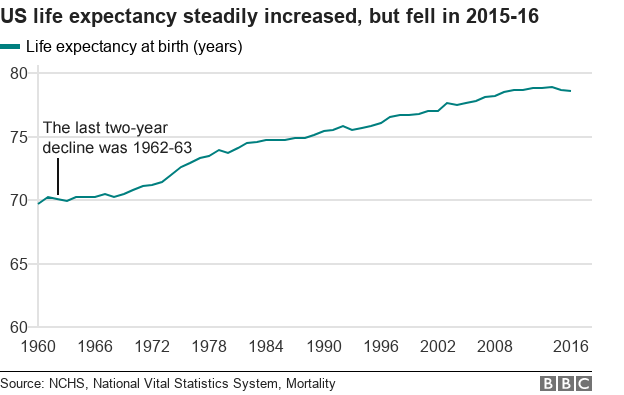
US life expectancy fell last year for a second year running for the first time in more than half a century, reportedly driven by the worsening opioid crisis.
Life expectancy in 2016 fell 0.1 years to 78.6, according to the National Center for Health Statistics.
It was the first consecutive drop since 1962-63. The last two-year decline before that was in the 1920s.
The previous fall in overall US life expectancy was a one-year drop in 1993, at the height of the Aids epidemic.
Years of over-prescription of opioid painkillers in the US has created a nationwide addiction crisis, with some patients turning to heroin and other street drugs when their prescriptions stop.
"The key factor in all this is the increase in drug overdose deaths," said Robert Anderson, the chief of mortality statistics at the National Center for Health Statistics (NCHS), calling the two-year drop "shocking".

In 2016, 63,600 people died from a drug overdose, according to the Centers for Disease Control and Prevention (CDC) - up 21% from the previous year and three times the rate in 1999.
Opioid-related overdoses increased by 28%, killing 42,249 people, mostly in the 25-to-54 age group.
A life expectancy drop again in 2017 would represent the first three-year fall since the catastrophic outbreak of Spanish flu 100 years ago.
More on the US opioid crisis
 GETTY IMAGES
GETTY IMAGES
The dramatic increase in overdoses is being driven by synthetic opioids such as fentanyl, which has flooded the US market and is 100 times more powerful than heroin.
Many users unknowingly buy heroin that has been cut with fentanyl, leaving them with no control over the strength of the hit they take.
Overdoses from synthetic opioids jumped to 19,410 in 2016 from 9,580 in 2015 and 5,540 in 2014, according to the report.
Death rates fell for seven of the 10 leading causes of death, including heart disease, cancer, stroke and diabetes. offsetting the increase in overdoses.
"If those hadn't declined to the extent they did then of course things would look worse," said Mr Anderson.

The 2016 death rate increased 9.7% for unintentional injuries, 3.1% for Alzheimer's - partly due to an aging population - and 1.5% for suicide.
In a separate report, the CDC linked a 133% increase in hepatitis C cases between 2004 and 2014 to the increase in users injecting opioids.
In October, President Donald Trump declared the opioid crisis a public health emergency.
He stopped short of declaring a national emergency, which would have freed up more federal funds to combat the crisis.
Originally published on http://www.bbc.com/news/world-us-canada-42452733

No comments:
Post a Comment
Note: Only a member of this blog may post a comment.